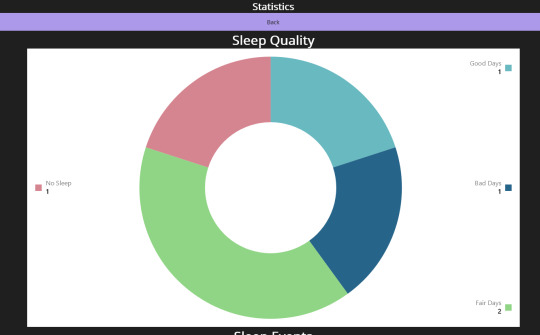#App Development Challenge
Explore tagged Tumblr posts
Text
Experiment #2.2 Doubling Down: Two Google Gemini AI Apps in 30 Days – My Journey
Hello everyone! 👋 Yesterday, I shared my pivot from my initial app idea due to a saturated market. This led me to explore new horizons with the Google Gemini API. Today, I’m thrilled to announce an even bolder challenge: developing two apps in the next 30 days! Two Apps, Two Purposes Public Project: Your Guide to AI App Development. My original concept, a goal-setting app, will continue…
#30-Day Challenge#AI App Development#AI-Powered Apps#App Development Challenge#App Development Process#Behind the Scenes#Building in Public#Goal-Setting Apps#Google AI Tools#Google Gemini API#Indie Developer#Patreon Exclusive#Solo Developer#Startup Journey#Tech Entrepreneur
1 note
·
View note
Text




Days 110 to 118 of coding everyday for a year and I've gotten so much done!
I finish both of my finals the C++ and the C#. The C++ final is an adventure game and it wasn't too challenging to make honestly I had fun with it. The C# project was also fun because I got to play with microcharts when creating the statistics page to display collected data! I plan to make the C++ game more fun honestly because I can't just let it die from here. I am going to make the Android and iOS build better on the C# project. I'm really proud of myself today :)
My next adventures will be brushing up on JavaScript since I'm severely out of practice and using what I know to make my portfolio website using Blazor!
#self improvement#cosmickittytalk#codeblr#csharp programming#csharp#csharp is superior#girls who code#programming#coding challenge#coding for a year#coding exercises#coding#learning new syntax#learning programming#learning to code#college homework#college life#college finals#computer science major#programmer#work in progress#maui app#.net developers#.net framework#.net development#.net core#.net maui#.net#c++ course#c++ programming
17 notes
·
View notes
Note
chapter 4 warms my heart so much!! and has unlocked memories from my childhood… my dad was also my primary caregiver growing up and i would always wake up earlier than him, watching cartoons while waiting for him to wake up (i had the job of defrosting whatever frozen good i wanted cooked for breakfast!) orrr playing with my toys while hes preparing dinner hahaha dad!lando scenes straight out of my childhood!! emma and lando feel so real!!
Chapter 4
stop i'll weep.........
a lot of writing dad lando was just scrounging through my own memory for like... niche parts of childhood? i've written before about how i think the thing that makes fics feel most real and immersive (which is my primary goal with my writing) is including throwaway casual details. worldbuilding, essentially, i guess! but yeah, my process was just trying to think of every apparent mundanity from my childhood or the childhoods i've witnessed and weaving them all together. every time someone says 'omg we did that when i was a kid!' about dad lando an angel gets their wings.
so glad the fic is landing for you :,)
#answered#dad lando#my notes app of 'weird things kids said' that i built between 2016 and 2019 came in clutch for things like uh#phraseology?#“you're my best daddy ever”#“i just feel like i miss you a little bit”#some others later as well#making a kid SOUND and ACT and THINK like a kid of the target age is like. tricky.#like the hardest part of writing emma was making her age feel consistent and correct#also an extra challenge is that this fic's in-universe timeline spans six months#so like.... kids develop! quickly! chapter 16 emma is fully a different kind of person than chapter 2 emma#anyway. lots of thoughts about how i made emma-related decisions in this fic if anybody wants to hear more idk
3 notes
·
View notes
Text
Toward a code-breaking quantum computer
New Post has been published on https://thedigitalinsider.com/toward-a-code-breaking-quantum-computer/
Toward a code-breaking quantum computer


The most recent email you sent was likely encrypted using a tried-and-true method that relies on the idea that even the fastest computer would be unable to efficiently break a gigantic number into factors.
Quantum computers, on the other hand, promise to rapidly crack complex cryptographic systems that a classical computer might never be able to unravel. This promise is based on a quantum factoring algorithm proposed in 1994 by Peter Shor, who is now a professor at MIT.
But while researchers have taken great strides in the last 30 years, scientists have yet to build a quantum computer powerful enough to run Shor’s algorithm.
As some researchers work to build larger quantum computers, others have been trying to improve Shor’s algorithm so it could run on a smaller quantum circuit. About a year ago, New York University computer scientist Oded Regev proposed a major theoretical improvement. His algorithm could run faster, but the circuit would require more memory.
Building off those results, MIT researchers have proposed a best-of-both-worlds approach that combines the speed of Regev’s algorithm with the memory-efficiency of Shor’s. This new algorithm is as fast as Regev’s, requires fewer quantum building blocks known as qubits, and has a higher tolerance to quantum noise, which could make it more feasible to implement in practice.
In the long run, this new algorithm could inform the development of novel encryption methods that can withstand the code-breaking power of quantum computers.
“If large-scale quantum computers ever get built, then factoring is toast and we have to find something else to use for cryptography. But how real is this threat? Can we make quantum factoring practical? Our work could potentially bring us one step closer to a practical implementation,” says Vinod Vaikuntanathan, the Ford Foundation Professor of Engineering, a member of the Computer Science and Artificial Intelligence Laboratory (CSAIL), and senior author of a paper describing the algorithm.
The paper’s lead author is Seyoon Ragavan, a graduate student in the MIT Department of Electrical Engineering and Computer Science. The research will be presented at the 2024 International Cryptology Conference.
Cracking cryptography
To securely transmit messages over the internet, service providers like email clients and messaging apps typically rely on RSA, an encryption scheme invented by MIT researchers Ron Rivest, Adi Shamir, and Leonard Adleman in the 1970s (hence the name “RSA”). The system is based on the idea that factoring a 2,048-bit integer (a number with 617 digits) is too hard for a computer to do in a reasonable amount of time.
That idea was flipped on its head in 1994 when Shor, then working at Bell Labs, introduced an algorithm which proved that a quantum computer could factor quickly enough to break RSA cryptography.
“That was a turning point. But in 1994, nobody knew how to build a large enough quantum computer. And we’re still pretty far from there. Some people wonder if they will ever be built,” says Vaikuntanathan.
It is estimated that a quantum computer would need about 20 million qubits to run Shor’s algorithm. Right now, the largest quantum computers have around 1,100 qubits.
A quantum computer performs computations using quantum circuits, just like a classical computer uses classical circuits. Each quantum circuit is composed of a series of operations known as quantum gates. These quantum gates utilize qubits, which are the smallest building blocks of a quantum computer, to perform calculations.
But quantum gates introduce noise, so having fewer gates would improve a machine’s performance. Researchers have been striving to enhance Shor’s algorithm so it could be run on a smaller circuit with fewer quantum gates.
That is precisely what Regev did with the circuit he proposed a year ago.
“That was big news because it was the first real improvement to Shor’s circuit from 1994,” Vaikuntanathan says.
The quantum circuit Shor proposed has a size proportional to the square of the number being factored. That means if one were to factor a 2,048-bit integer, the circuit would need millions of gates.
Regev’s circuit requires significantly fewer quantum gates, but it needs many more qubits to provide enough memory. This presents a new problem.
“In a sense, some types of qubits are like apples or oranges. If you keep them around, they decay over time. You want to minimize the number of qubits you need to keep around,” explains Vaikuntanathan.
He heard Regev speak about his results at a workshop last August. At the end of his talk, Regev posed a question: Could someone improve his circuit so it needs fewer qubits? Vaikuntanathan and Ragavan took up that question.
Quantum ping-pong
To factor a very large number, a quantum circuit would need to run many times, performing operations that involve computing powers, like 2 to the power of 100.
But computing such large powers is costly and difficult to perform on a quantum computer, since quantum computers can only perform reversible operations. Squaring a number is not a reversible operation, so each time a number is squared, more quantum memory must be added to compute the next square.
The MIT researchers found a clever way to compute exponents using a series of Fibonacci numbers that requires simple multiplication, which is reversible, rather than squaring. Their method needs just two quantum memory units to compute any exponent.
“It is kind of like a ping-pong game, where we start with a number and then bounce back and forth, multiplying between two quantum memory registers,” Vaikuntanathan adds.
They also tackled the challenge of error correction. The circuits proposed by Shor and Regev require every quantum operation to be correct for their algorithm to work, Vaikuntanathan says. But error-free quantum gates would be infeasible on a real machine.
They overcame this problem using a technique to filter out corrupt results and only process the right ones.
The end-result is a circuit that is significantly more memory-efficient. Plus, their error correction technique would make the algorithm more practical to deploy.
“The authors resolve the two most important bottlenecks in the earlier quantum factoring algorithm. Although still not immediately practical, their work brings quantum factoring algorithms closer to reality,” adds Regev.
In the future, the researchers hope to make their algorithm even more efficient and, someday, use it to test factoring on a real quantum circuit.
“The elephant-in-the-room question after this work is: Does it actually bring us closer to breaking RSA cryptography? That is not clear just yet; these improvements currently only kick in when the integers are much larger than 2,048 bits. Can we push this algorithm and make it more feasible than Shor’s even for 2,048-bit integers?” says Ragavan.
This work is funded by an Akamai Presidential Fellowship, the U.S. Defense Advanced Research Projects Agency, the National Science Foundation, the MIT-IBM Watson AI Lab, a Thornton Family Faculty Research Innovation Fellowship, and a Simons Investigator Award.
#2024#ai#akamai#algorithm#Algorithms#approach#apps#artificial#Artificial Intelligence#author#Building#challenge#classical#code#computer#Computer Science#Computer Science and Artificial Intelligence Laboratory (CSAIL)#Computer science and technology#computers#computing#conference#cryptography#cybersecurity#defense#Defense Advanced Research Projects Agency (DARPA)#development#efficiency#Electrical Engineering&Computer Science (eecs)#elephant#email
5 notes
·
View notes
Text
Something I don't think we talk enough about in discussions surrounding AI is the loss of perseverance.
I have a friend who works in education and he told me about how he was working with a small group of HS students to develop a new school sports chant. This was a very daunting task for the group, in large part because many had learning disabilities related to reading and writing, so coming up with a catchy, hard-hitting, probably rhyming, poetry-esque piece of collaborative writing felt like something outside of their skill range. But it wasn't! I knew that, he knew that, and he worked damn hard to convince the kids of that too. Even if the end result was terrible (by someone else's standards), we knew they had it in them to complete the piece and feel super proud of their creation.
Fast-forward a few days and he reports back that yes they have a chant now... but it's 99% AI. It was made by Chat-GPT. Once the kids realized they could just ask the bot to do the hard thing for them - and do it "better" than they (supposedly) ever could - that's the only route they were willing to take. It was either use Chat-GPT or don't do it at all. And I was just so devastated to hear this because Jesus Christ, struggling is important. Of course most 14-18 year olds aren't going to see the merit of that, let alone understand why that process (attempting something new and challenging) is more valuable than the end result (a "good" chant), but as adults we all have a responsibility to coach them through that messy process. Except that's become damn near impossible with an Instantly Do The Thing app in everyone's pocket. Yes, AI is fucking awful because of plagiarism and misinformation and the environmental impact, but it's also keeping people - particularly young people - from developing perseverance. It's not just important that you learn to write your own stuff because of intellectual agency, but because writing is hard and it's crucial that you learn how to persevere through doing hard things.
Write a shitty poem. Write an essay where half the textual 'evidence' doesn't track. Write an awkward as fuck email with an equally embarrassing typo. Every time you do you're not just developing that particular skill, you're also learning that you did something badly and the world didn't end. You can get through things! You can get through challenging things! Not everything in life has to be perfect but you know what? You'll only improve at the challenging stuff if you do a whole lot of it badly first. The ability to say, "I didn't think I could do that but I did it anyway. It's not great, but I did it," is SO IMPORTANT for developing confidence across the board, not just in these specific tasks.
Idk I'm just really worried about kids having to grow up in a world where (for a variety of reasons beyond just AI) they're not given the chance to struggle through new and challenging things like we used to.
38K notes
·
View notes
Text
9 Real Challenges in Mobile App Development

In today’s fast-moving digital world, mobile apps are more than just utilities—they’re a core part of how businesses interact with their customers. Whether it's shopping, booking services, or managing accounts, users expect seamless app experiences that are fast, secure, and intuitive. But behind the scenes, developing a high-quality app is no small feat. Even the most experienced teams face hurdles that can delay launches, increase costs, or damage user trust.
If you’re working with a mobile app development company in New York or planning to hire an app developer in NYC, it's critical to understand these real-world challenges. In this blog, we explore 9 major obstacles in mobile app development—and how businesses can tackle them effectively.
1. Platform Compatibility and Fragmentation
Developers often face the choice between building for iOS, Android, or both. While cross-platform frameworks like Flutter and React Native help, platform fragmentation remains a challenge. Android, for example, runs on a wide range of devices and OS versions, each with its quirks.
An experienced app development company in New York will know how to ensure compatibility across platforms and devices—optimising code for performance, UI consistency, and hardware variation.
Tip: Consider your audience. If your users are primarily in the U.S., iOS-first might be a smart move. If you’re going global, Android deserves priority.
2. UI/UX Design Consistency
A beautiful and intuitive design is non-negotiable today. However, achieving UI/UX consistency across different devices, screen sizes, and operating systems is a real challenge. Poor design leads to user frustration, app abandonment, and bad reviews.
That's why partnering with a mobile app development company in New York that has a strong in-house design team is crucial. They’ll perform A/B testing, user interviews, and apply platform-specific design guidelines to build interfaces that resonate with your target audience.
3. Performance and Speed
Users have zero patience for laggy apps. According to research, nearly 80% of users will uninstall an app that’s too slow or buggy. Developers need to optimise code, reduce load times, and manage backend API calls efficiently.
A skilled mobile app developer in New York will know how to build lean, fast applications using tools like lazy loading, caching, and compression. Speed isn’t a luxury—it’s a baseline expectation.
4. Data Security and Privacy
From fintech to healthcare, mobile apps often handle sensitive user data. Ensuring robust security is a legal and ethical obligation, especially with regulations like GDPR and CCPA in play.
Key considerations include:
End-to-end encryption
Secure authentication (2FA, biometrics)
Secure data storage (e.g., Keychain, Android Keystore)
A trusted app developer in New York will help you implement these measures while maintaining performance and usability.
5. Integration with Third-Party Services
Most modern apps are not standalone—they integrate with payment gateways, CRMs, analytics tools, social platforms, and more. However, managing these integrations is tricky:
APIs change frequently
Downtime or errors in third-party services affect your app
There are risks of data breaches through external platforms
A reliable app development company in New York will follow best practices for API management, fallback logic, and secure integrations to ensure smooth functionality even if third-party services are down.
6. Testing Across Devices and Environments
Manual testing is no longer sufficient. You need automated tests that simulate real-world usage across different screen sizes, network conditions, and OS versions. Unfortunately, testing at this scale is complex and time-consuming.
Leading mobile app developers in New York use cloud-based testing platforms and CI/CD pipelines to:
Automate regression testing
Simulate low-bandwidth environments
Detect memory leaks and battery drain
If your testing strategy isn’t robust, you're launching blind—and that can backfire quickly.
7. App Store Approval Processes
Both Apple and Google have strict guidelines and review processes. Rejections are common due to:
Privacy violations
Incomplete information
Bugs or crashes
UI not meeting design standards
A well-established app development company in New York will help you navigate these hurdles, ensuring that your app meets all submission criteria and avoids costly delays.
Bonus Tip: Keep documentation, privacy policies, and feature explanations clear and concise—this helps during the review.
8. Scalability Challenge
Maybe your app is great for 1,000 users—but what happens when you reach 100,000? Scalability is a core architectural concern. Apps that aren’t built to scale will crash under heavy loads or cost a fortune in infrastructure.
Smart app developers in NYC anticipate this from day one. They’ll:
Use cloud-native backends (AWS, Firebase, Azure)
Set up autoscaling and load balancing
Optimize database queries and storage
Think long-term. Launching is just the beginning—scaling is the real game.
9. Ongoing Maintenance and Updates
Mobile apps require continuous support—bug fixes, OS compatibility updates, feature improvements, and user feedback integration. Many companies underestimate the cost and effort of post-launch maintenance.
When choosing an app development company in New York, make sure they offer long-term support and version management. You’ll need to push updates regularly to stay relevant and secure.
Apps that don’t evolve quickly become obsolete—and your users will move on.
Bonus Challenge: Hiring the Right Talent
One of the biggest hidden challenges is finding the right app developer in New York. The tech talent pool is vast, but not all developers are equal. Look for:
A proven track record
Strong UX/UI portfolio
Knowledge of the latest frameworks and technologies
A clear process for testing, feedback, and scaling
An ideal mobile app developer in New York will act as a strategic partner, not just a vendor. They’ll challenge your ideas, propose better solutions, and ensure your app succeeds long after launch.
Final Thoughts
Mobile app development is an exciting but complex journey. From idea to execution, every stage brings its own unique challenges. Whether it’s platform fragmentation, security, testing, or scalability, having the right team in your corner makes all the difference.
If you’re looking to build a mobile app that’s secure, scalable, and user-friendly, consider partnering with a seasoned mobile app development company in New York. With local insight, technical expertise, and a deep understanding of market trends, these professionals can help you bring your app vision to life—and keep it thriving long after launch.
In the highly competitive app landscape of NYC, working with the right app developer in NYC isn’t just helpful—it’s essential.
Need help starting your app project? Whether you're a startup, a mid-sized business, or a global enterprise, the right mobile app developer in New York can turn your app idea into a high-impact solution. Reach out today for a consultation or discovery call and take the first step toward building something great.
Learn more https://winklix.wixsite.com/winklix/single-post/the-latest-impact-of-5g-technology-on-mobile-app-development-hip-or-hype
#mobile app development company in new york#app development company in new york#mobile app developer in new york#app developer in new york#app developer in nyc#9 Real Challenges in Mobile App Development
0 notes
Text
Using Mobile Apps to Enhance E-commerce Efficiency
Efficiency in e-commerce processes is essential, and mobile apps assist in attaining this by automating processes, offering analytics, and improving customer service. They make processes like order management and inventory control easier, allowing businesses to operate efficiently. Discover how to streamline your e-commerce business with mobile apps by checking out this blog.
1 note
·
View note
Text
AI and Health: New Technologies Paving the Way for Better Treatment
Artificial intelligence (AI) is expanding rapidly in the health sector, and it is revolutionizing our medical system. With the help of AI, new technologies are being developed that are not only helpful in accurately diagnosing diseases but are also playing an important role in personalized treatment and management.

Quick and accurate diagnosis of diseases AI-based tools can now analyze medical imaging data such as X-rays, CT scans, and MRIs quickly and accurately. This helps doctors to quickly detect complex conditions such as cancer, heart diseases, and neurological problems.
Personalized medicine AI can help create personalized treatment plans for every individual by analyzing genomics and biometrics. This technology ensures that the patient gets the right medicine and the right dose at the right time.
Improved health management AI-based health apps and wearables such as smart watches are now helping people monitor their health condition. These devices regularly track health indicators such as heart rate, blood pressure and sleep quality.
Accelerating medical research The role of AI has become extremely important in the development of new drugs and vaccines. Using AI, scientists can analyze complex data sets and make new medical discoveries faster.
Accessible and affordable healthcare AI technology is helping in delivering affordable and effective healthcare, even in rural and remote areas. Telemedicine and virtual health assistants are bridging the gap between patients and doctors.
Conclusion Artificial intelligence is playing an important role in making healthcare more effective, accurate, and accessible. However, there are challenges such as data security and ethics in the use of AI technology which need to be dealt with. In the coming years, with more advanced and innovative uses of AI, the healthcare landscape may change completely.
#AI and Health: New Technologies Paving the Way for Better Treatment#Artificial intelligence (AI) is expanding rapidly in the health sector#and it is revolutionizing our medical system. With the help of AI#new technologies are being developed that are not only helpful in accurately diagnosing diseases but are also playing an important role in#Quick and accurate diagnosis of diseases#AI-based tools can now analyze medical imaging data such as X-rays#CT scans#and MRIs quickly and accurately. This helps doctors to quickly detect complex conditions such as cancer#heart diseases#and neurological problems.Personalized medicine#AI can help create personalized treatment plans for every individual by analyzing genomics and biometrics. This technology ensures that the#AI-based health apps and wearables such as smart watches are now helping people monitor their health condition. These devices regularly tra#blood pressure and sleep quality.Accelerating medical research#The role of AI has become extremely important in the development of new drugs and vaccines. Using AI#scientists can analyze complex data sets and make new medical discoveries faster.Accessible and affordable healthcare#AI technology is helping in delivering affordable and effective healthcare#even in rural and remote areas. Telemedicine and virtual health assistants are bridging the gap between patients and doctors.#Conclusion#Artificial intelligence is playing an important role in making healthcare more effective#accurate#and accessible. However#there are challenges such as data security and ethics in the use of AI technology which need to be dealt with. In the coming years#with more advanced and innovative uses of AI#the healthcare landscape may change completely.
1 note
·
View note
Text
Explore how to balance performance in cross-platform app development with efficient mobile app solutions. Learn strategies for performance optimisation, overcoming development challenges, and using top app development tools for creating optimised mobile apps. Discover solutions for tackling cross-platform performance issues with Quokka Labs.
#Cross-Platform App Development#Performance Optimisation#Mobile App Development#App Development Tools#Efficient Mobile Apps#Development Challenges#Optimised App Solutions#Cross-Platform Performance#Mobile App Optimisation#Quokka Labs Blog
0 notes
Text
deleted & reinstalled tumblr app to free up storage but the latest version for my ios is ugly af and barely functional kms
#lime.txt#love how 'smash cache' is just a button that literally does nothing#app developers never spare a thought for the storage capacity–challenged anymore smh
0 notes
Text

#PollTime Which is your preferred Mobile Development Framework?
a) React Native 🚀 b) Flutter 💙 c) Xamarin 🛠️ d) Swift 🖥️
Cast your vote in the comment session below! 🤔
#simplelogic#makingitsimple#itcompany#dropcomment#developer#developmemnt#android#androiddevlopment#software#app#application#appdevlopment#data#error#challenge#applifecycle#poll#polltime#techpoll#mobile
1 note
·
View note
Text

Decided to start my year with a personal challenge of coding something everyday for the whole year, and at the end of the year I'll have a reflection on my journey and what I've learned.
Today on day 1 I am working on a task management application in .Net Maui. This project will be for my personal use since I'm making it the exact way I want to make a task app vs what I've gotten before through Google Play.
So far I will say I'm enjoying working with C# 12 and .Net 8. Maui has been enjoyable so far despite me not being 100% comfortable with front end work. I'm working on the settings page currently and I'll be adding theme settings for the application.
See y'all tomorrow same time 😎
#self improvement#codeblr#cosmickittytalk#csharp programming#csharp is superior#csharp#.net development#.net framework#.net maui#.net developers#.net#app development#coding challenge#coding for a year
45 notes
·
View notes
Text
#Android vs iOS Development Challenges#iOS Development vs Android Development#Which is Harder: Android or iOS Development?#Android Development Complexity#iOS Development Complexity#Challenges in Android and iOS Development#Android vs iOS App Development Guide#Comparing Android and iOS Development#Which is More Complex: Android or iOS?#Mobile App Development Challenges: Android vs iOS
0 notes
Text

5 days 11 hours to try the weekly challenge on Swapple,
Are you up for the challenge?
Download Links below
#weekly challenge#logic puzzle#word puzzles#puzzle games#indie dev#game dev blog#game development#gaming#video games#games#ios 18#ios app development#ios#android#android games#android game development#so hot 🔥🔥🔥#mobile app development
0 notes
Text
An Insightful Blog on Overcoming Challenges in Shopify App Development
This blog provides a straightforward look at the common challenges faced in Shopify app development and practical solutions to overcome them. Learn about frequent issues developers encounter and discover effective strategies to address these problems, ensuring a smoother development process. Perfect for entrepreneurs seeking to improve their Shopify apps and tackle obstacles with confidence.
0 notes
Text
Top 5 Custom Software Development Challenges in the US

Talent Shortage:
Description: Finding skilled developers is increasingly difficult due to high demand and limited supply.
Impact: Delays in project timelines, increased costs, and potential compromises on quality.
Solution: Investing in training programs, leveraging remote teams, and offering competitive compensation.
Managing Client Expectations:
Description: Clients often have high expectations that may not align with technical feasibility or budget constraints.
Impact: Misunderstandings, scope creep, and dissatisfaction.
Solution: Clear communication, detailed requirement gathering, and regular progress updates.
Rapidly Changing Technology:
Description: The technology landscape evolves quickly, making it challenging to stay current.
Impact: Obsolete solutions, increased training needs, and potential security vulnerabilities.
Solution: Continuous learning, adopting flexible architectures, and maintaining a proactive approach to technology trends.
Security Concerns:
Description: Protecting sensitive data and ensuring software security is a major concern.
Impact: Data breaches, legal issues, and loss of client trust.
Solution: Implementing robust security measures, regular security audits, and adhering to best practices.
Scalability Issues:
Description: Ensuring that the software can handle growth in users and data without performance degradation.
Impact: Poor performance, user dissatisfaction, and increased maintenance costs.
Solution: Designing scalable architectures, thorough testing, and planning for future growth.
Web 2.0 transformed the web from a static, information-focused medium to a dynamic, participatory platform, significantly impacting communication, commerce, and entertainment.
Read more: Top 5 Custom Software Development Challenges in the US
#Custom Software Development#Software Development Companies in the US#mobile app development companies in the US#Software Development Challenges
0 notes